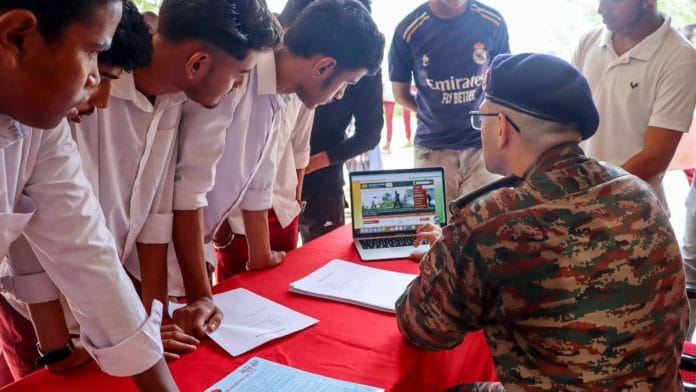New Delhi: Recruiting Agniveers for seven or eight years rather than four, retaining 60-70 percent of the recruits after this period rather than 25 percent, extending the training period to nine months from six — these are some of the changes that may be introduced to the Agnipath military recruitment scheme.
The scheme seems set for an overhaul in the wake of fresh controversy over its provisions after the National Democratic Alliance (NDA) came to power at the Centre for the third consecutive time this month.
The Janata Dal (United), a key partner of the BJP-led alliance, has demanded a review of the scheme that was launched in June 2022. It had immediately drawn violent nationwide protests, with the Hindi heartland impacted the most.
Under the scheme, people aged between 17-and-a-half and 21 are recruited as soldiers (Agniveers) in the three armed forces for a period of four years. They don’t have any pension entitlement or other benefits, and only 25 percent are retained after they complete their service duration.
The Army had in January this year started collecting empirical data about the Agniveers to ascertain how the Agnipath scheme can be tweaked for the best results, and it is believed that the scheme will go in for a major overhaul soon.
Speaking to ThePrint, Lt Gen Ashok K. Mehta (retd) said the government will likely announce a review soon, and it will be done by the armed forces and a few civilian officials.
The armed forces review every new scheme that is introduced. In the case of Agnipath, the feedback from the three forces has led them to reconsider certain aspects of the scheme.
One of these, according to reports, is the number of years that Agniveers can be retained. While currently the short-term recruits are taken in for a period of four years, it is being speculated that the number of years they can serve in the forces may go up to seven to eight.
Further, 75 percent of Agniveers are discharged from duty after four years and get a lump sum payment of around Rs 12 lakh, according to the current provisions. These numbers, too, are reportedly likely to undergo changes and retention may go up to at least 60-70 percent.
The training period, which is six months for Agniveers, may be changed to what it was for recruits prior to the introduction of the scheme — nine months.
Speculation is also rife that the recruitment age of Agniveers will now go up to 23 years for technical arms.
These changes have reportedly been suggested after internal feedback and have not yet been formally taken to the government.
Also Read: Agnipath an ember that can consume India. Why it’s an invitation to civil war
‘Shortage of personnel’
Since its launch, the Agnipath scheme has drawn flak, especially from veterans, for several reasons and primarily because it pertains to the human capital of the forces — which can impact the overall synergy and morale of personnel.
Pensions have been a major contention, given that most personnel below officer rank come from rural regions and belong to humble families. The benefit has been withheld from Agniveers while a regular soldier’s family will get it even after his or her death.
Another issue is that some of the Gorkha battalions may be disbanded if the Agnipath scheme is continued. These troops comprise Gorkhas from India as well as Nepal but there has been no recruitment from Nepal since the scheme was launched.
Lt Gen Mehta pointed out that manpower levels in the Army, Navy and Air Force — especially the Army — have shrunk considerably.
Alluding to the gap in recruitment during the pandemic years, he said that more personnel are retiring than coming in. The years of the Covid pandemic when no one was recruited created a gap of 1.5-2 lakh personnel, he added.
“Recruitment under the Agnipath scheme is just 40,000 for all three services, of which the Army quota is 28,000. Every year, approximately 60,000-70,000 people retire from the Army,” he explained.
He further said that as the scheme allows only 25 percent of the 28,000 personnel to be retained, the Army gets just 7,000 personnel.
“The idea of Agnipath was not just to make the profile of the armed forces youthful, but also to reduce salaries and pensions. With the current changes that are being talked about, it is surprising that the Army took so long to discover these figures,” he added, pointing out that there may be manpower shortages, especially for combat forces deployed along the Line of Control and the Line of Actual Control.
‘Should be rolled back’
Maj Gen Yash Mor (retd), one of the most vocal critics of the Agnipath scheme, told ThePrint that it would “ruin the cohesion in units, where personnel will be wary of each other and will try to compete with one another to retain their position”.
He further pointed out that personnel who had joined the forces before the pandemic (or before the Agnipath scheme) ger 90 days’ leave, whereas Agniveers get only 30 days’ leave per year. This will affect their mental state as they will only be able to go home twice for 15 days each, he said.
According to Maj Gen Mor, if the scheme continues, in the future, almost 70-80 percent of an Army unit would consist of Agniveers, with very few personnel who had been inducted before Agnipath. And the bulk of the personnel, being Agniveers would lack technical expertise, he added.
On the changes to the scheme said to be in the works, he said: “This is a knee-jerk reaction. They should not have introduced the scheme. I think it should be rolled back completely. Major policy changes revolving around human resources should always undergo a pilot test.”
(Edited by Nida Fatima Siddiqui)
Also Read: Towards a ‘gender-agnostic’ force? Army looks at inducting women Agniveers in non-combat roles






